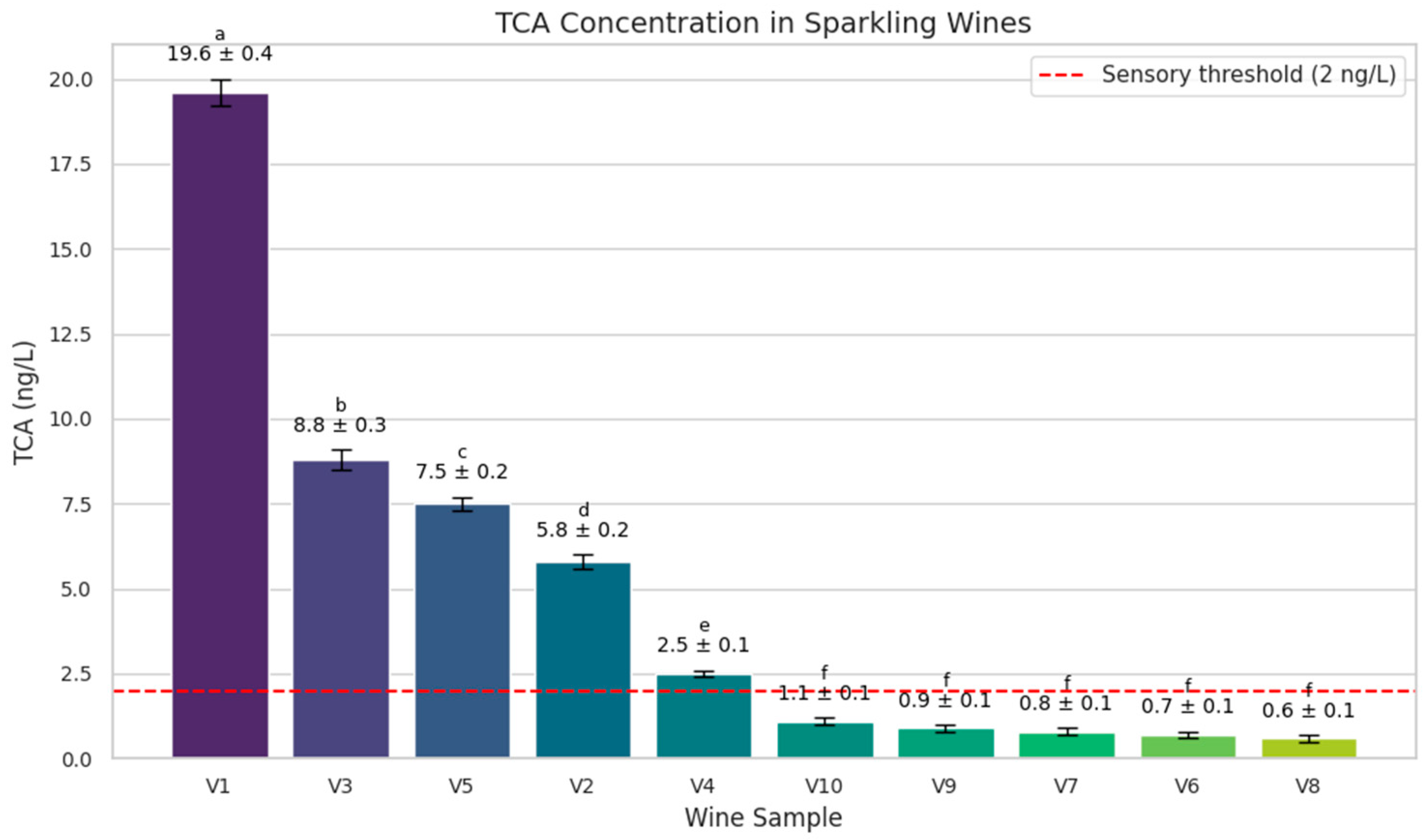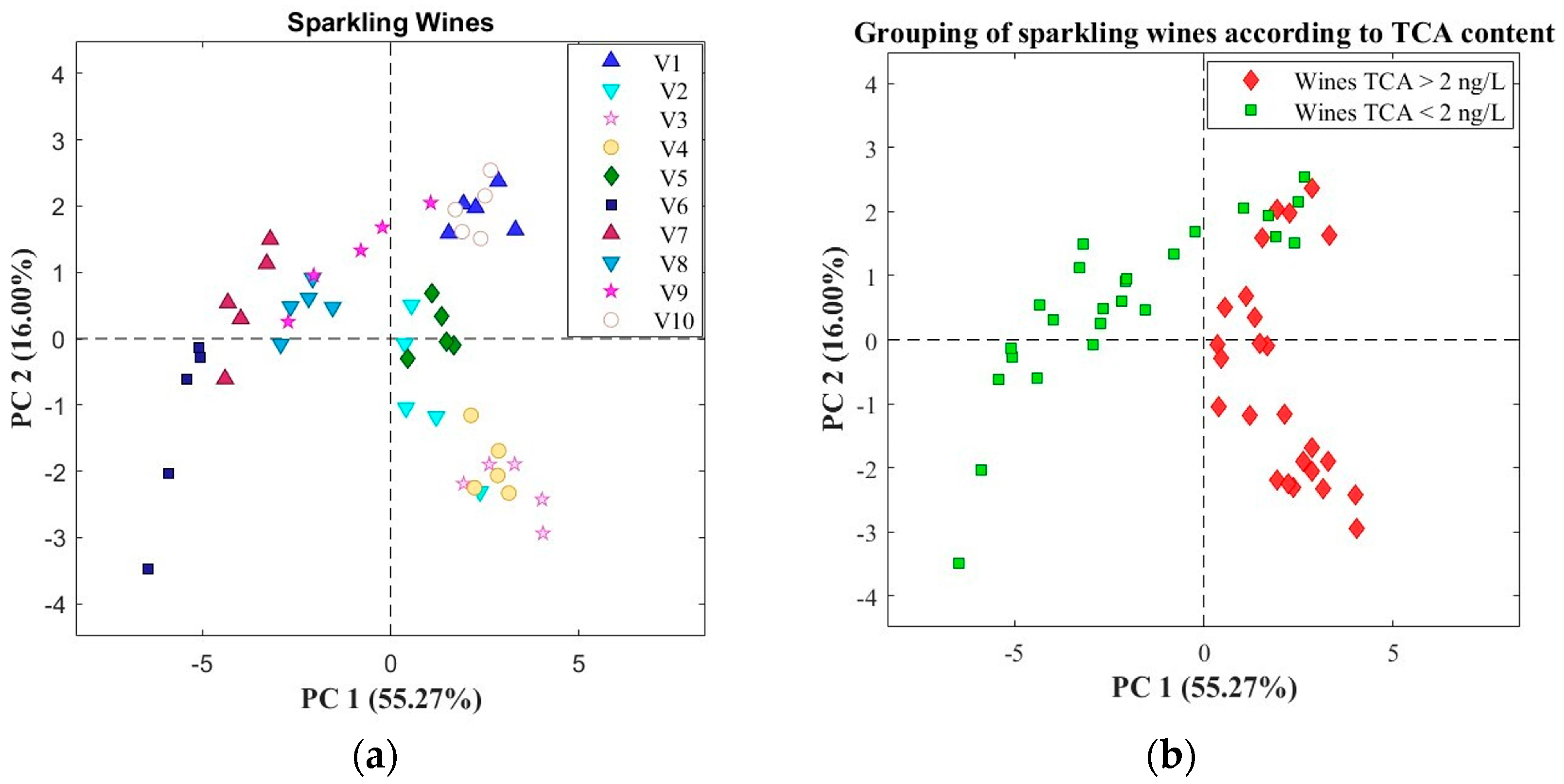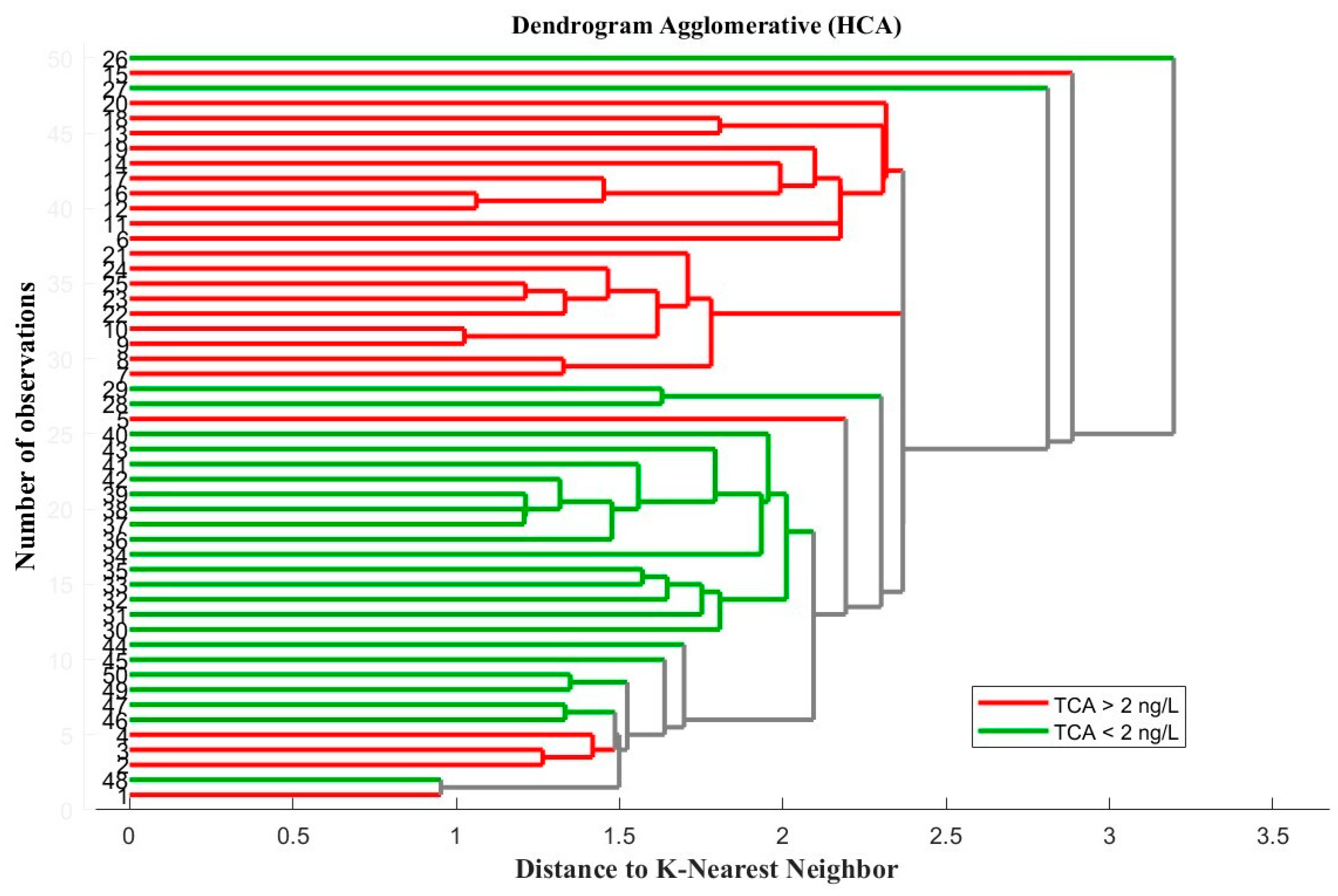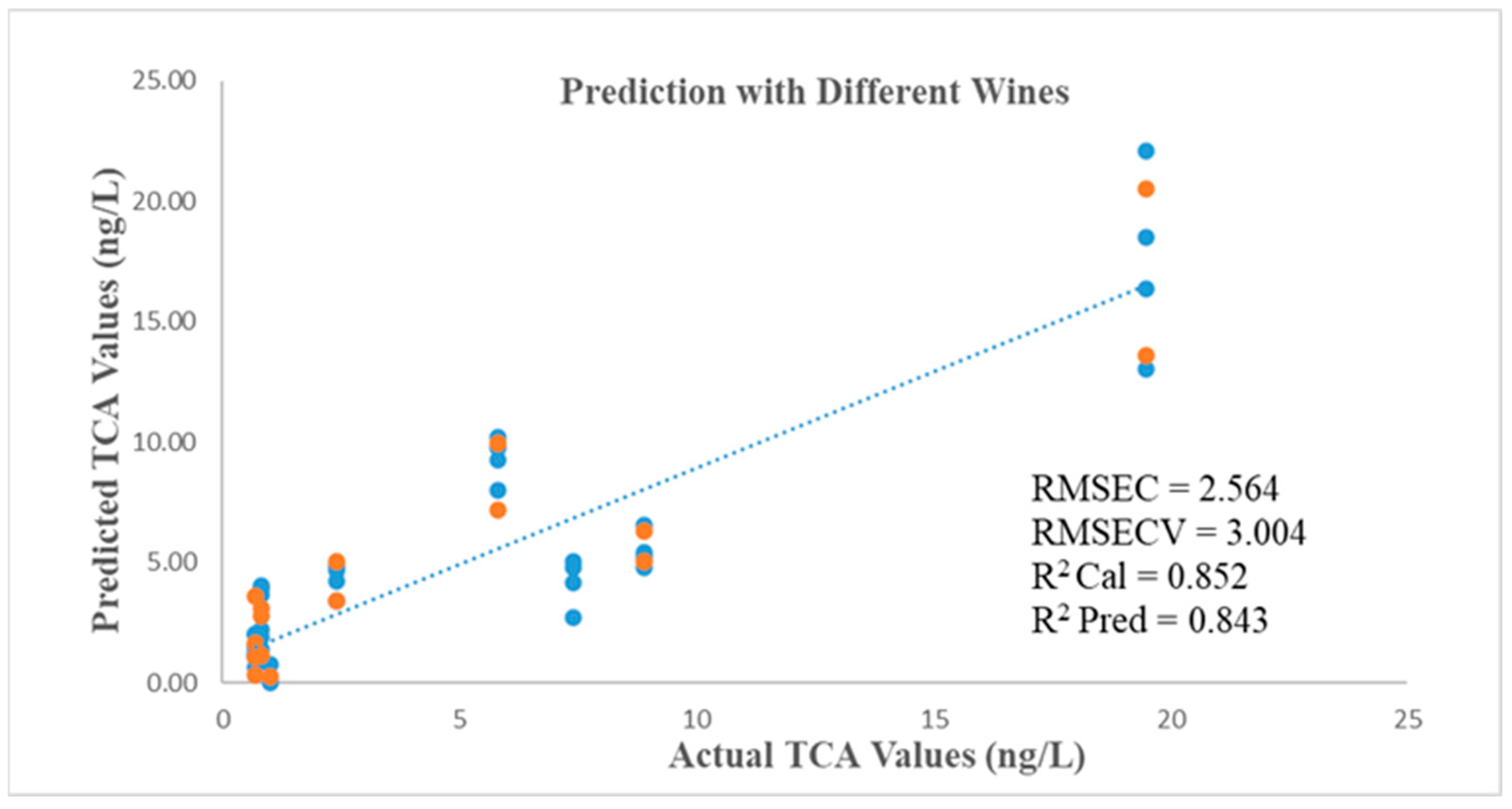Detection of 2,4,6-Trichloroanisole in Sparkling Wines Using a Portable E-Nose and Chemometric Tools
Abstract
1. Introduction
2. Materials and Methods
2.1. Experimental Design
2.1.1. Discrimination of Sparkling Wines Based on TCA Content
2.1.2. Quantitative TCA Prediction Using the E-Nose
2.2. Chromatographic Analysis
2.3. E-Nose System
2.4. Multivariate Data Analysis
3. Results
3.1. Chromatographic Analysis:
3.2. E-Nose Analysis
4. Discussion
5. Conclusions
Author Contributions
Funding
Institutional Review Board Statement
Informed Consent Statement
Data Availability Statement
Acknowledgments
Conflicts of Interest
Abbreviations
| ANNDA | Artificial Neural Network Discriminant Analysis |
| GC-MS | Gas Chromatography–Mass Spectrometry |
| GC-MS/MS | Gas Chromatography–Tandem Mass Spectrometry |
| MOS | Metal Oxide Semiconductor |
| PCA | Principal Component Analysis |
| PLS | Partial Least Squares |
| PLS-R | Partial Least Squares Regression |
| R2 | Coefficient of Determination |
| RT | Retention Time |
| SPME | Solid-Phase Microextraction |
| TCA | 2,4,6-Trichloroanisole |
| TVOC | Total Volatile Organic Compounds |
| VOCs | Volatile Organic Compounds |
References
- Jos, Á.; Moreno, I.; González, A.; Repetto, G.; Cameán, A. Differentiation of sparkling wines (cava and champagne) according to their mineral content. Talanta 2004, 63, 377–382. [Google Scholar] [CrossRef] [PubMed]
- Keng, A.; Botezatu, A. Uncorking Haloanisoles in Wine. Molecules 2023, 28, 2532. [Google Scholar] [CrossRef] [PubMed]
- Tarasov, A.; Cabral, M.; Loisel, C.; Lopes, P.; Schuessler, C.; Jung, R. State-of-the-Art Knowledge about 2,4,6-Trichloroanisole (TCA) and Strategies to Avoid Cork Taint in Wine. In Advances in Grape and Wine Biotechnology; IntechOpen: London, UK, 2022. [Google Scholar] [CrossRef]
- Capone, D.; Skouroumounis, G.; Barker, D.; McLean, H.; Pollnitz, A.; Sefton, M. Absorption of chloroanisoles from wine by corks and by other materials. Aust. J. Grape Wine Res. 1999, 5, 91–98. [Google Scholar] [CrossRef]
- Vasserot, Y.; Pitois, C.; Jeandet, P. Protective effect of a composite cork stopper on Champagne wine pollution with 2,4,6-trichloroanisole. Am. J. Enol. Vitic. 2001, 52, 280–281. [Google Scholar] [CrossRef]
- Cravero, M.; Bonello, F.; Alvarez, M.; Tsolakis, C.; Borsa, D. The sensory evaluation of 2,4,6-trichloroanisole in wines. J. Inst. Brew. 2015, 121, 411–417. [Google Scholar] [CrossRef]
- Tempere, S.; Schaaper, M.H.; Cuzange, E.; de Revel, G.; Sicard, G. Masking of several olfactory notes by infra-threshold concentrations of 2,4,6-trichloroanisole. Chemosens. Percept. 2017, 10, 69–80. [Google Scholar] [CrossRef]
- Fontana, A.; Patil, S.; Banerjee, K.; Altamirano, J. Ultrasound-assisted emulsification microextraction for determination of 2,4,6-trichloroanisole in wine samples by gas chromatography tandem mass spectrometry. J. Agric. Food Chem. 2010, 58, 4576–4581. [Google Scholar] [CrossRef] [PubMed]
- Alfieri, G.; Modesti, M.; Riggi, R.; Bellincontro, A. Recent Advances and Future Perspectives in the E-Nose Technologies Addressed to the Wine Industry. Sensors 2024, 24, 2293. [Google Scholar] [CrossRef] [PubMed]
- Arroyo, T.; Lozano, J.; Cabellos, J.M.; Gil-Diaz, M.; Santos, J.P.; Horrillo, M.C. Evaluation of wine aromatic compounds by a sensory human panel and an electronic nose. J. Agric. Food Chem. 2009, 57, 11543–11549. [Google Scholar] [CrossRef] [PubMed]
- Rodríguez-Méndez, M.L.; De Saja, J.A.; González-Antón, R.; García-Hernández, C.; Medina-Plaza, C.; García-Cabezón, C.; Martín-Pedrosa, F. Electronic noses and tongues in wine industry. Front. Bioeng. Biotechnol. 2016, 4, 81. [Google Scholar] [CrossRef] [PubMed]
- Meléndez, F.; Arroyo, P.; Gómez-Suárez, J.; Palomeque-Mangut, S.; Suárez, J.I.; Lozano, J. Portable electronic nose based on digital and analog chemical sensors for 2,4,6-trichloroanisole discrimination. Sensors 2022, 22, 3453. [Google Scholar] [CrossRef]
- Santos, J.P.; Sayago, I.; Sanjurjo, J.L.; Pérez-Coello, M.S.; Díaz-Maroto, M.C. Rapid and non-destructive analysis of corky off-flavors in natural cork stoppers by a wireless and portable electronic nose. Sensors 2022, 22, 4687. [Google Scholar] [CrossRef] [PubMed]
- Moreno-Arribas, M.V.; Polo, M.C. Wine Chemistry and Biochemistry; Springer: New York, NY, USA, 2009. [Google Scholar] [CrossRef]
- Riu-Aumatell, M.; Bosch-Fusté, J.; López-Tamames, E.; Buxaderas, S. Development of volatile compounds of cava (Spanish sparkling wine) during long ageing time in contact with lees. Food Chem. 2006, 95, 237–242. [Google Scholar] [CrossRef]
- Arroyo, P.; Meléndez, F.; Suárez, J.I.; Herrero, J.L.; Rodríguez, S.; Lozano, J. Electronic Nose with Digital Gas Sensors Connected via Bluetooth to a Smartphone for Air Quality Measurements. Sensors 2020, 20, 786. [Google Scholar] [CrossRef] [PubMed]
- Abdi, H.; Williams, L.J. Principal component analysis. Wiley Interdiscip. Rev. Comput. Stat. 2010, 2, 433–459. [Google Scholar] [CrossRef]
- Baldwin, E.A.; Bai, J.; Plotto, A.; Dea, S. Electronic noses and tongues: Applications for the food and pharmaceutical industries. Sensors 2011, 11, 4744–4766. [Google Scholar] [CrossRef] [PubMed]
- Lozano, J.; Santos, J.P.; Arroyo, T.; Aznar, M.; Cabellos, J.M.; Gil, M.; Horrillo, M.C. Correlating E-nose responses to wine sensorial descriptors and GC-MS profiles using partial least squares regression. Sens. Actuators B Chem. 2007, 127, 267–276. [Google Scholar] [CrossRef]
- Carrasco, L.V. Sensory Quality Control of Alcoholic Beverages Using Fast Chemical Sensors. Ph.D. Thesis, Universitat Rovira i Virgili, Tarragona, Spain, 2010. Available online: http://hdl.handle.net/10803/8576 (accessed on 29 March 2025).







| Sensor | Manufacturer | Signals |
|---|---|---|
| BME680 | Bosch Sensortech Gmbh, Reutlingen, Germany | Temperature, Relative Humidity, Pressure, Resistance value (Ω) |
| SGP30 | Sensirion AG, Stäfa, Switzerland | CO2, TVOCs 1, H2 (raw signal 2), Ethanol (raw signal) |
| ZMOD4410 | Renesas Electronic Corporation, Tokyo, Japan | Ethanol (raw signal), Resistance value (Ω), CO2, TVOCs, IAQ 3 |
| CCS811 | ScioSense B.V., Eindhoven, The Netherlands | CO2, TVOCs, Resistance value |
| iAQ-Core | ScioSense B.V., Eindhoven, The Netherlands | CO2 (ppm), TVOCs (ppb) y Resistance value (Ω) |
| Name | RT (min) | CAS Nº | Odor Descriptor | Area ×107 | |||||||||
|---|---|---|---|---|---|---|---|---|---|---|---|---|---|
| V1 | V2 | V3 | V4 | V5 | V6 | V7 | V8 | V9 | V10 | ||||
| Ethanol | 1.68 | 64-17-5 | sharp and alcoholic smell | 217.78 ± 3.80 bc | 213.26± 5.65 bc | 217.01 ± 3.61 bc | 197.72 ± 5.02 d | 224.84 ± 5.52 ab | 76.58 ± 2.35 e | 221.21 ± 6.99 b | 214.46 ± 3.76 bc | 238.76 ± 5.79 a | 205.74 ± 4.91 cd |
| 1-Butanol, 3-methyl- | 4.27 | 123-51-3 | alcoholic, pungent, cognac, fruity, banana | 50.25 ± 1.04 e | 53.38 ± 1.53 de | 60.83 ± 2.64 ab | 55.20 ± 2.24 cde | 57.43 ± 0.64 abcd | 62.41 ± 2.06 a | 61.89 ± 1.44 a | 59.22 ± 2.60 abc | 57.76 ± 2.15 abcd | 56.55 ± 0.22 bcd |
| Ethyl 2-hydroxypropanoate | 6.95 | 687-47-8 | rum, with fruity and creamy notes | 12.21 ± 0.34 d | 13.05 ± 0.16 cd | 14.63 ± 0.55 ab | 14.08 ± 0.30 bc | 14.30 ± 0.22 ab | 14.86 ± 0.26 ab | 14.81 ± 0.62 ab | 15.34 ± 0.36 a | 15.27 ± 0.46 a | 14.38 ± 0.06 ab |
| 2,2-Dimethyl-1-butanol | 8.36 | 1185-33-7 | soft, sweet and slightly fruity or floral smell | 0.40 ± 0.02 | 0.13 ± 0.00 | nd | nd | 0.26 ± 0.01 | nd | 0.25 ± 0.00 | nd | 0.32 ± 0.01 | nd |
| Ethyl 2-methylbutanoate | 8.53 | 7452-79-1 | strong and unpleasant smell, similar to cheese | 0.27 ± 0.01 c | 0.21 ± 0.01 d | 0.27 ± 0.01 c | 0.21 ± 0.01d | 0.23 ± 0.01 d | 0.70 ± 0.02 a | 0.27 ± 0.00 bc | 0.23 ± 0.00 d | 0.15 ± 0.01 e | 0.29 ± 0.01 b |
| Ethyl 3-methylbutanoate | 8.69 | 108-64-5 | fruity, apple, pineapple | 0.43 ± 0.01 c | 0.37 ± 0.01 d | 0.53 ± 0.02 ab | 0.41 ± 0.01 c | 0.42 ± 0.01 c | 0.56 ± 0.01 a | 0.50 ± 0.01 b | 0.43 ± 0.02 c | 0.34 ± 0.01 d | 0.55 ± 0.02 a |
| 1-Hexanol | 9.68 | 111-27-3 | fresh, herbaceous smell | 0.73 ± 0.02 a | 0.67 ± 0.02 ab | 0.69 ± 0.02 ab | 0.72 ± 0.02 a | 0.70 ± 0.02 ab | 0.71 ± 0.02 ab | 0.70 ± 0.02 a | 0.72 ± 0.01 ab | 0.67 ± 0.02 ab | 0.65 ± 0.02 a |
| 3-Methylbutyl acetate | 9.83 | 123-92-2 | pleasant, fruity, and sweet smell | 0.73 ± 0.02 d | 0.80 ± 0.03 cd | 0.92 ± 0.01 b | 0.80 ± 0.02 c | 0.91 ± 0.02 b | 0.97 ± 0.02 ab | 0.94 ± 0.02 ab | 0.94 ± 0.03 ab | 0.83 ± 0.03 c | 0.99 ± 0.04 a |
| Ethyl hexanoate | 16.18 | 123-66-0 | tropical fruit/pineapple | 38.44 ± 0.75 a | 30.47 ± 0.59 de | 35.16 ± 0.92 bc | 32.78 ± 0.44 cd | 30.86 ± 0.77 de | 38.03 ± 0.76 a | 28.11 ± 0.89 e | 34.03 ± 1.14 bc | 24.11 ± 0.35 f | 35.94 ± 1.60 ab |
| Hexanoic acid | 17.96 | 142-62-1 | strong and unpleasant smell of rancid fat | 2.21 ± 0.07 e | 3.78 ± 0.04 a | 3.26 ± 0.10c | 3.43 ± 0.07 bc | 3.74 ± 0.06 a | 2.95 ± 0.04 d | 1.41 ± 0.04 f | 3.66 ± 0.16 ab | 3.39 ± 0.08 c | 0.59 ± 0.02 g |
| Nonanal | 21.49 | 124-19-6 | fresh and citrusy smell, with floral nuances | 0.51 ± 0.02 d | 0.62 ± 0.02 b | 0.40 ± 0.01 e | 0.67 ± 0.01 a | 0.65 ± 0.01 ab | 0.66 ± 0.01 ab | 0.55 ± 0.01 cd | 0.69 ± 0.03 a | 0.57 ± 0.02 c | 0.45 ± 0.01 e |
| 2-Phenylethanol | 22.07 | 60-12-8 | sweet and floral scent of roses | 8.65 ± 0.24 a | 6.14 ± 0.20 b | 4.50 ± 0.12 de | 4.81 ± 0.06 d | 5.33 ± 0.14 c | 2.88 ± 0.10 h | 4.01 ± 0.14 f | 4.30 ± 0.02 ef | 3.37 ± 0.13 g | 3.16 ± 0.07 gh |
| Diethyl succinate | 25.40 | 123-25-1 | fruity, reminiscent of apples or grapes | 14.84 ± 0.58 a | 14.64 ± 0.32 ab | 14.14 ± 0.08 ab | 14.28 ± 0.41 ab | 14.01 ± 0.30 ab | 13.84 ± 0.44 ab | 13.71 ± 0.54 ab | 14.46 ± 0.47 ab | 13.88 ± 0.27 ab | 13.45 ± 0.57 b |
| Ethyl octanoate | 26.15 | 106-32-1 | sweet fruity, brandy-, apple and banana-like | 54.44 ± 1.91 bcd | 52.32 ± 0.31 cd | 50.45 ± 0.92 d | 50.04 ± 1.89 d | 41.99 ± 1.38 e | 58.28 ± 2.57 ab | 36.13 ± 1.52 f | 56.43 ± 0.70 bc | 29.82 ± 0.89 g | 61.86 ± 2.94 a |
| Decanal | 26.46 | 112-31-2 | aldehydic type odor | 0.39 ± 0.01 | 0.26 ± 0.01 | 0.59 ± 0.01 | nd | 0.46 ± 0.01 | nd | 0.83 ± 0.02 | nd | nd | nd |
| Octanoic Acid | 27.12 | 124-07-2 | slightly unpleasant rancid-like smell | 14.95 ± 0.37 d | 19.39 ± 0.74 b | 16.49 ± 0.43 cd | 18.82 ± 0.73 b | 18.36 ± 0.52 b | 14.85 ± 0.37 d | 19.30 ± 0.45 b | 21.66 ± 0.78 a | 12.10 ± 0.46 e | 18.15 ± 0.81 bc |
| Ethyl decanoate | 35.03 | 110-38-3 | waxy, fruity, sweet-apple, nut-like, winey | 2.41 ± 0.07 a | 2.48 ± 0.06 a | 1.70 ± 0.04 de | 1.83 ± 0.07 cd | 1.59 ± 0.03 ef | 1.87 ± 0.06 cd | 1.44 ± 0.04 fg | 0.19 ± 0.01 h | 1.35 ± 0.04 g | 2.17 ± 0.06 b |
| Actual Class | ||
|---|---|---|
| Predicted Class | >2 ng/L TCA | <2 ng/L TCA |
| >2 ng/L TCA | 23 | 4 |
| <2 ng/L TCA | 2 | 21 |
| Class | TPR (Recall) | FPR | TNR | FNR | N | Err | P (Precision) | F1 (F1 Score) |
|---|---|---|---|---|---|---|---|---|
| >2 ng/L TCA | 0.92 | 0.16 | 0.84 | 0.08 | 25 | 0.12 | 0.85 | 0.88 |
| <2 ng/L TCA | 0.84 | 0.08 | 0.92 | 0.16 | 25 | 0.12 | 0.91 | 0.87 |
| Matthew’s Correlation Coefficient (MCC) = 0.76 | ||||||||
Disclaimer/Publisher’s Note: The statements, opinions and data contained in all publications are solely those of the individual author(s) and contributor(s) and not of MDPI and/or the editor(s). MDPI and/or the editor(s) disclaim responsibility for any injury to people or property resulting from any ideas, methods, instructions or products referred to in the content. |
© 2025 by the authors. Licensee MDPI, Basel, Switzerland. This article is an open access article distributed under the terms and conditions of the Creative Commons Attribution (CC BY) license (https://creativecommons.org/licenses/by/4.0/).
Share and Cite
Sánchez, R.; Lozano, J.; Arroyo, P.; Meléndez, F. Detection of 2,4,6-Trichloroanisole in Sparkling Wines Using a Portable E-Nose and Chemometric Tools. Chemosensors 2025, 13, 178. https://doi.org/10.3390/chemosensors13050178
Sánchez R, Lozano J, Arroyo P, Meléndez F. Detection of 2,4,6-Trichloroanisole in Sparkling Wines Using a Portable E-Nose and Chemometric Tools. Chemosensors. 2025; 13(5):178. https://doi.org/10.3390/chemosensors13050178
Chicago/Turabian StyleSánchez, Ramiro, Jesús Lozano, Patricia Arroyo, and Félix Meléndez. 2025. "Detection of 2,4,6-Trichloroanisole in Sparkling Wines Using a Portable E-Nose and Chemometric Tools" Chemosensors 13, no. 5: 178. https://doi.org/10.3390/chemosensors13050178
APA StyleSánchez, R., Lozano, J., Arroyo, P., & Meléndez, F. (2025). Detection of 2,4,6-Trichloroanisole in Sparkling Wines Using a Portable E-Nose and Chemometric Tools. Chemosensors, 13(5), 178. https://doi.org/10.3390/chemosensors13050178








